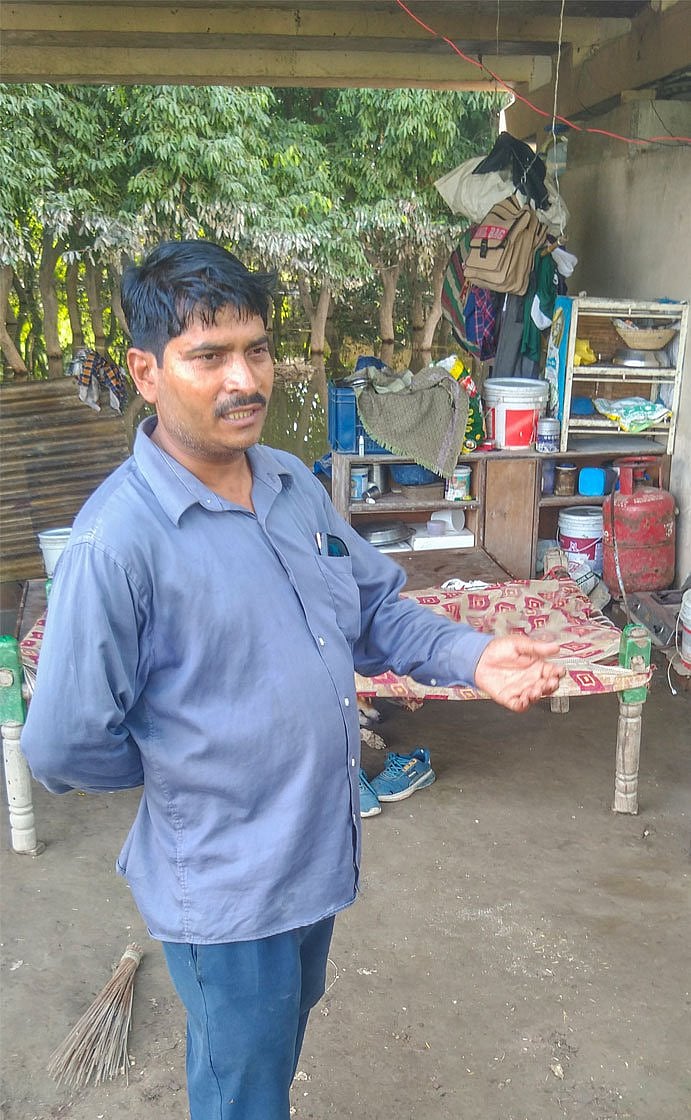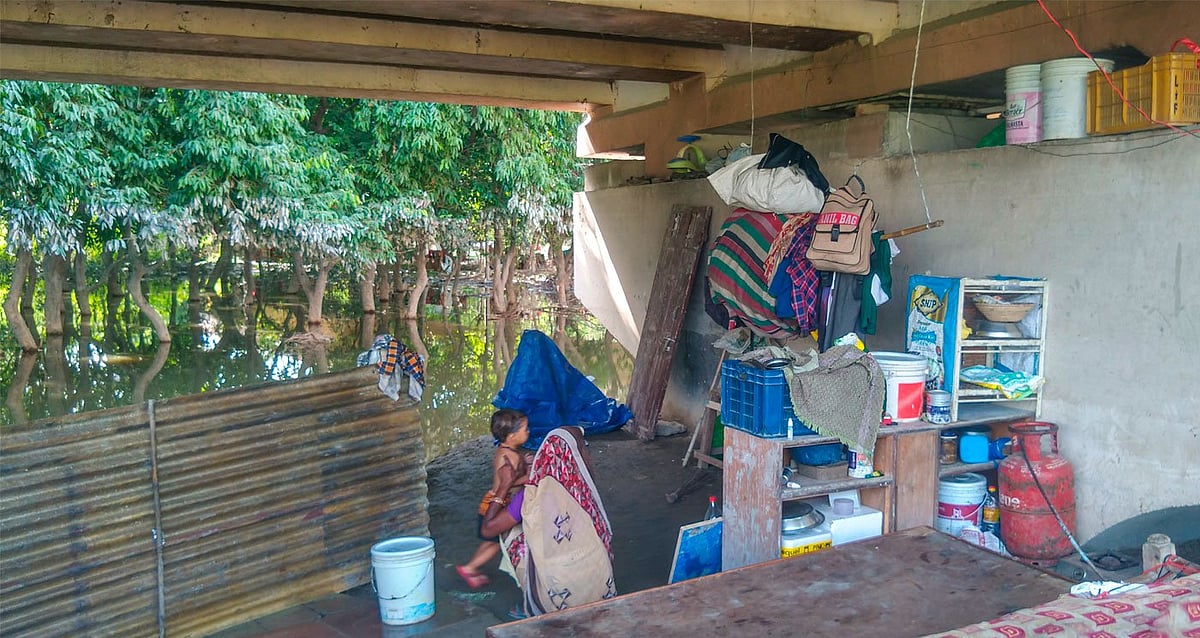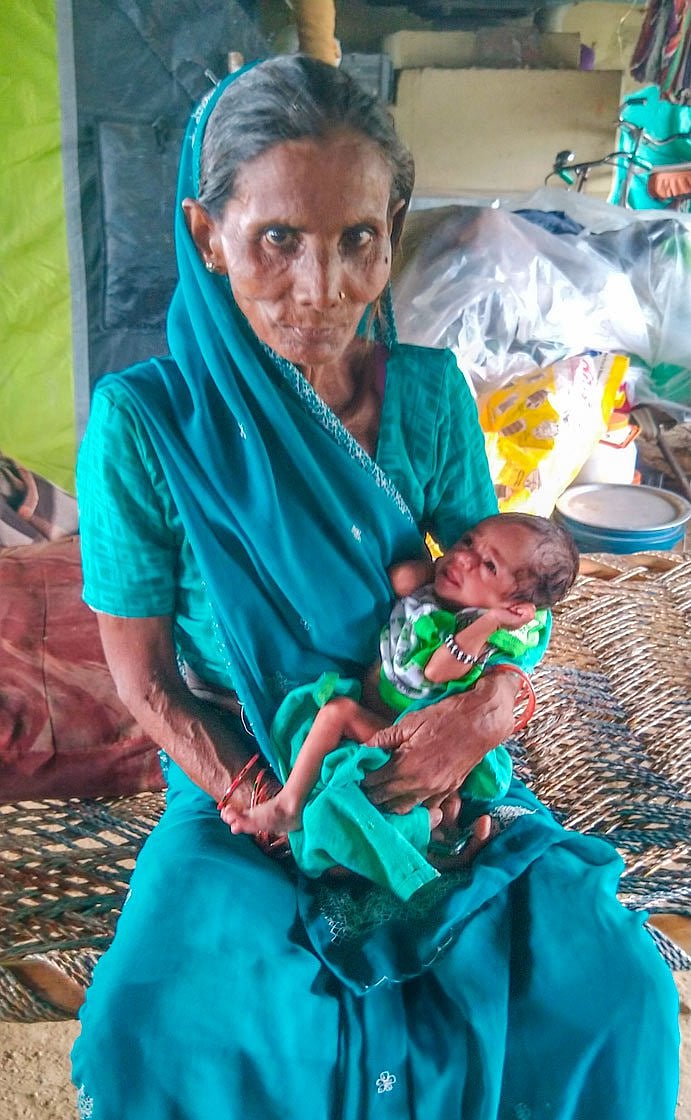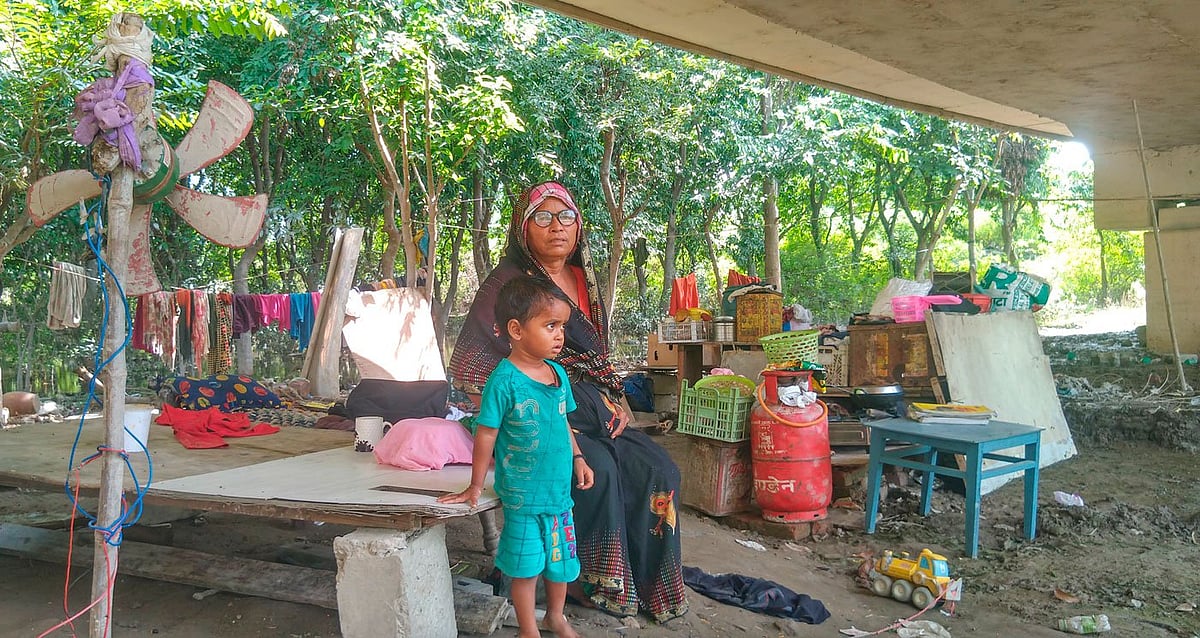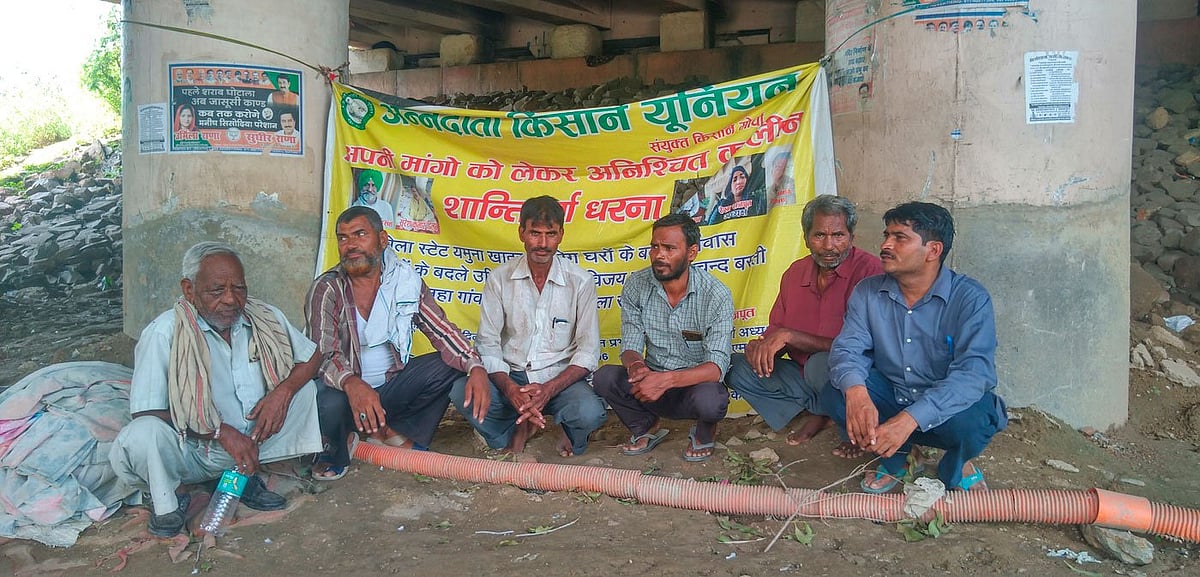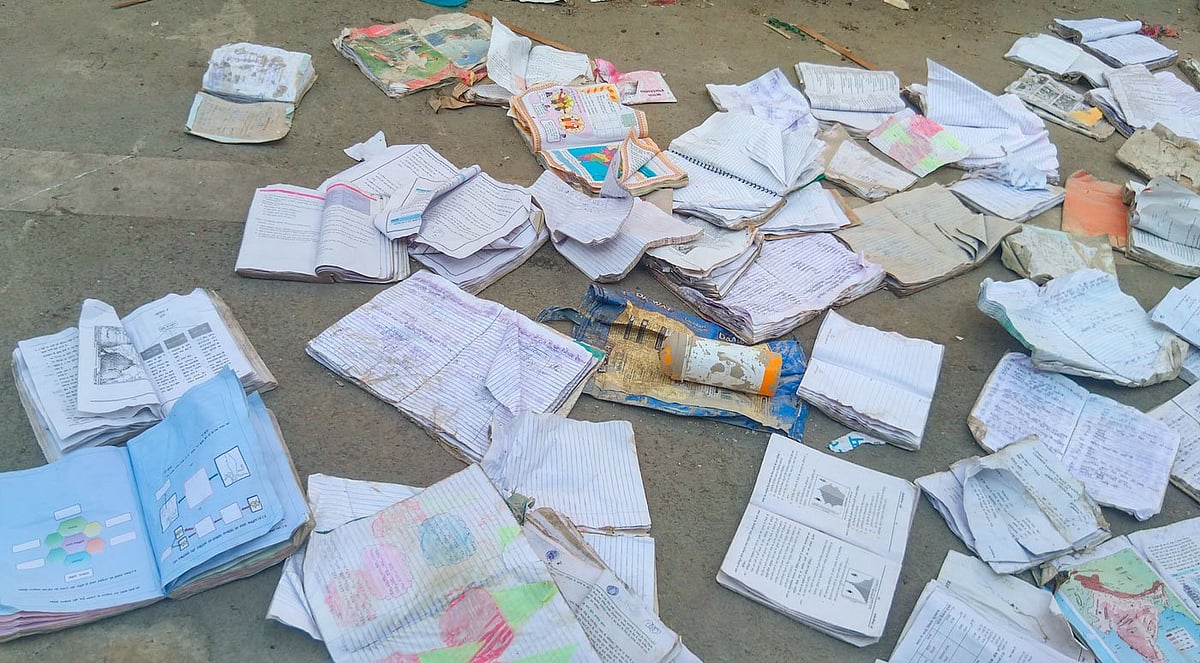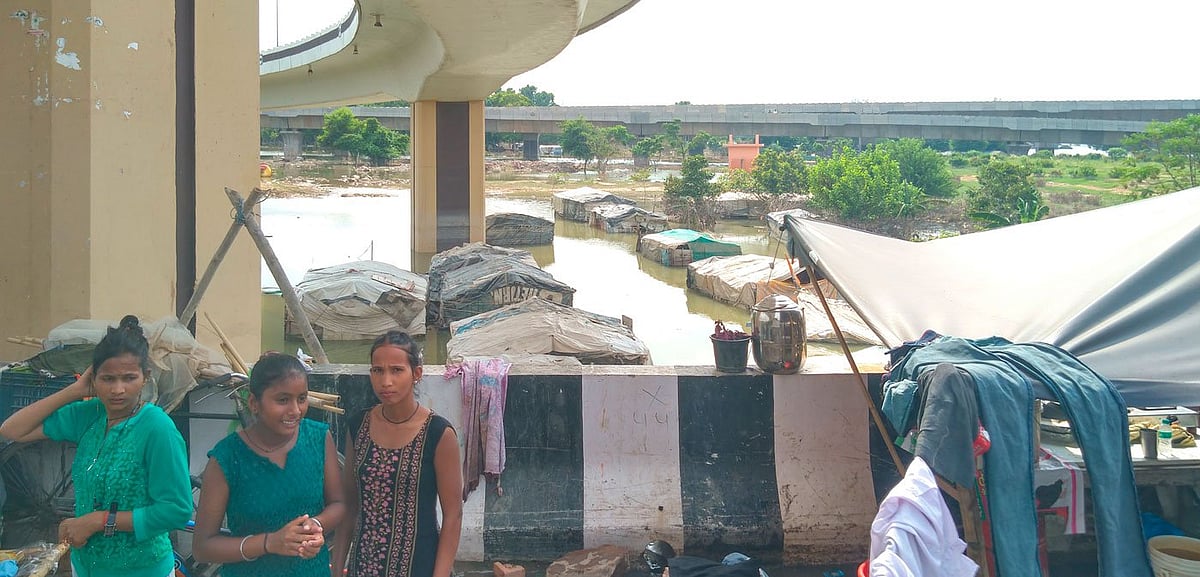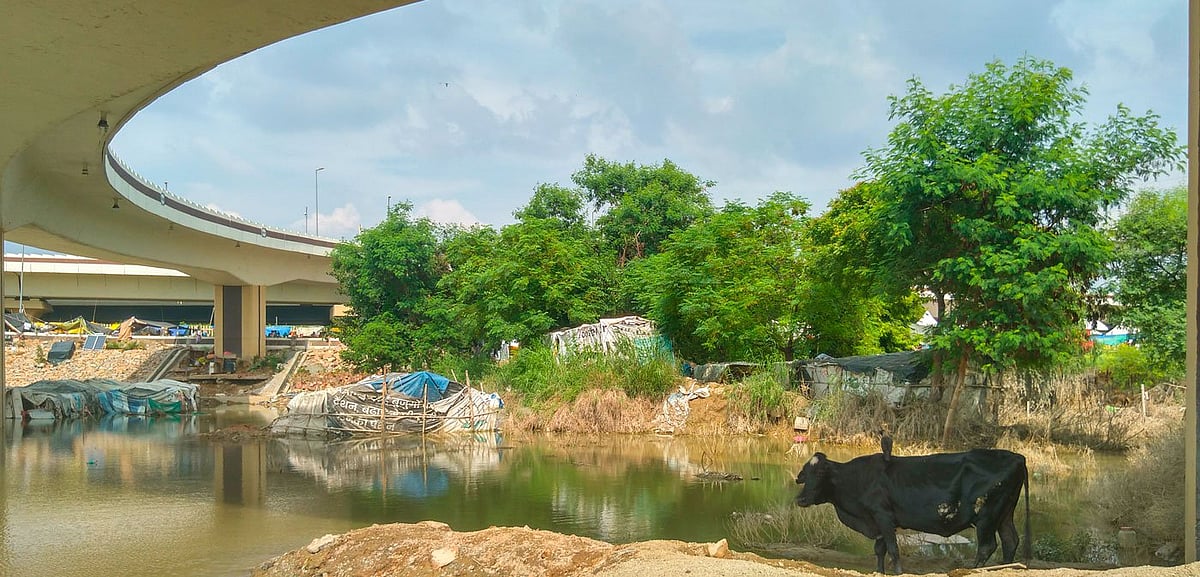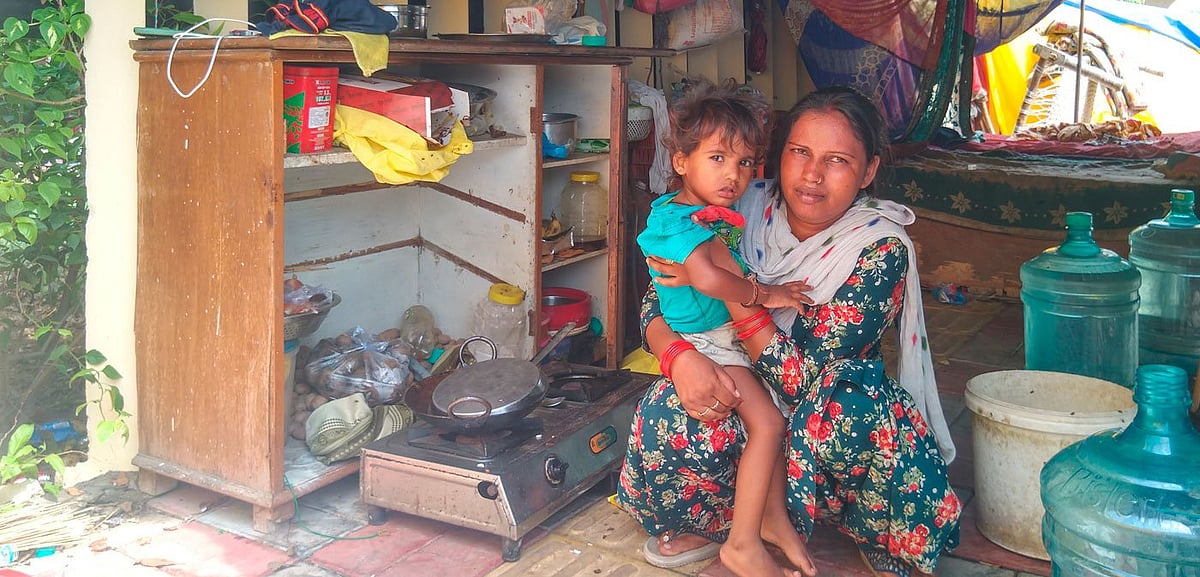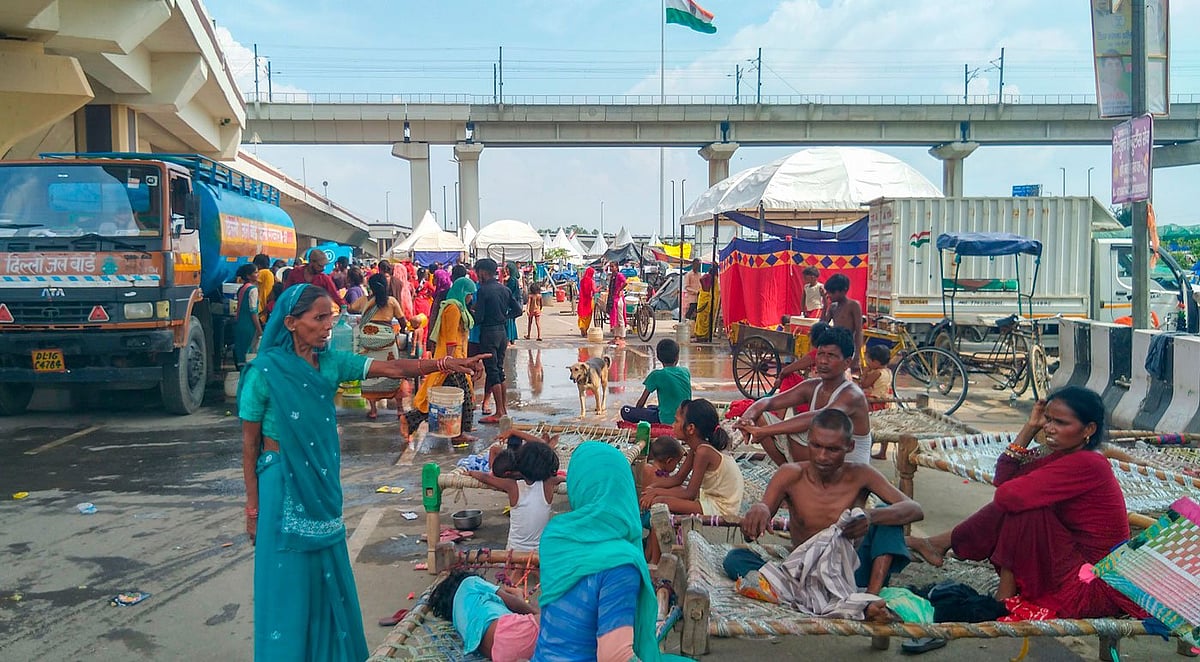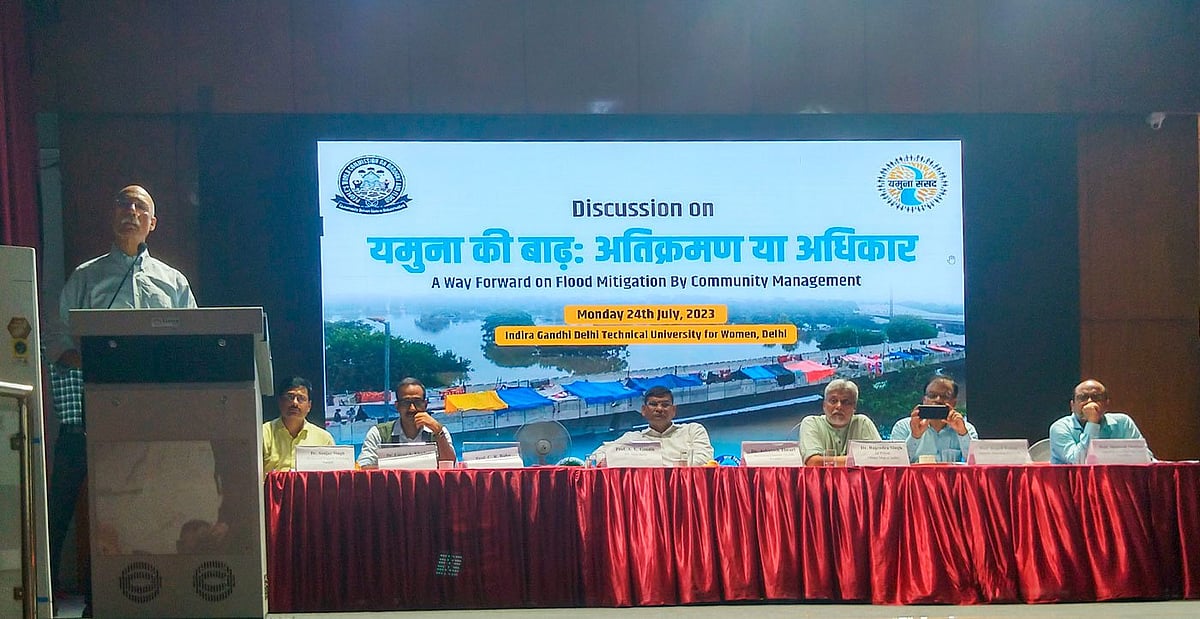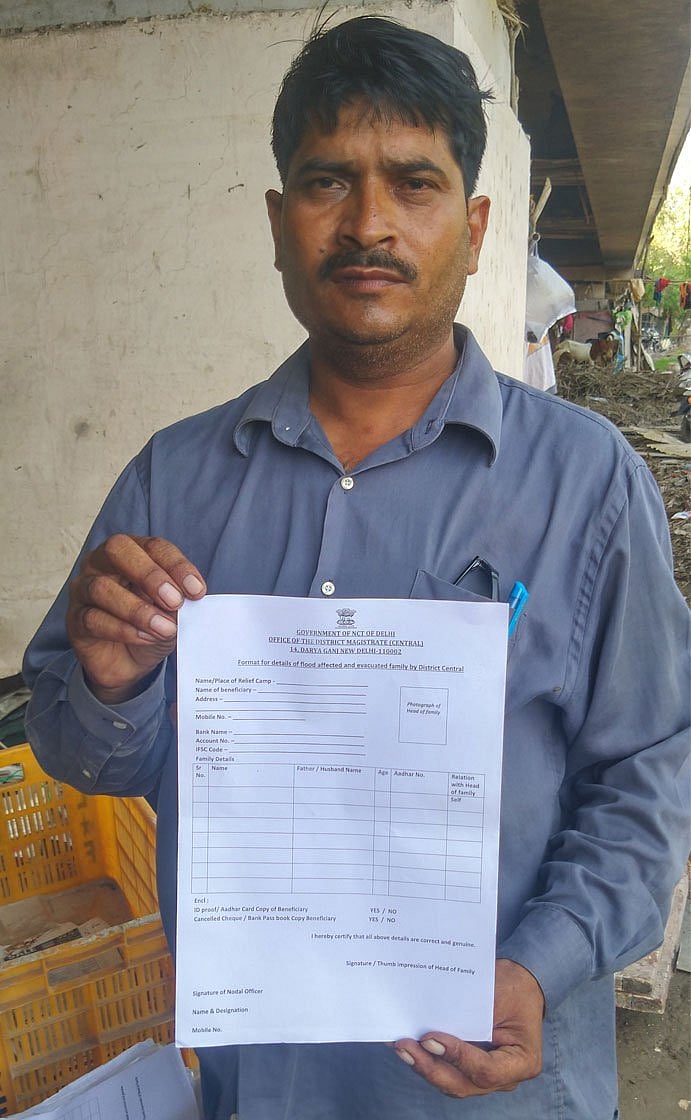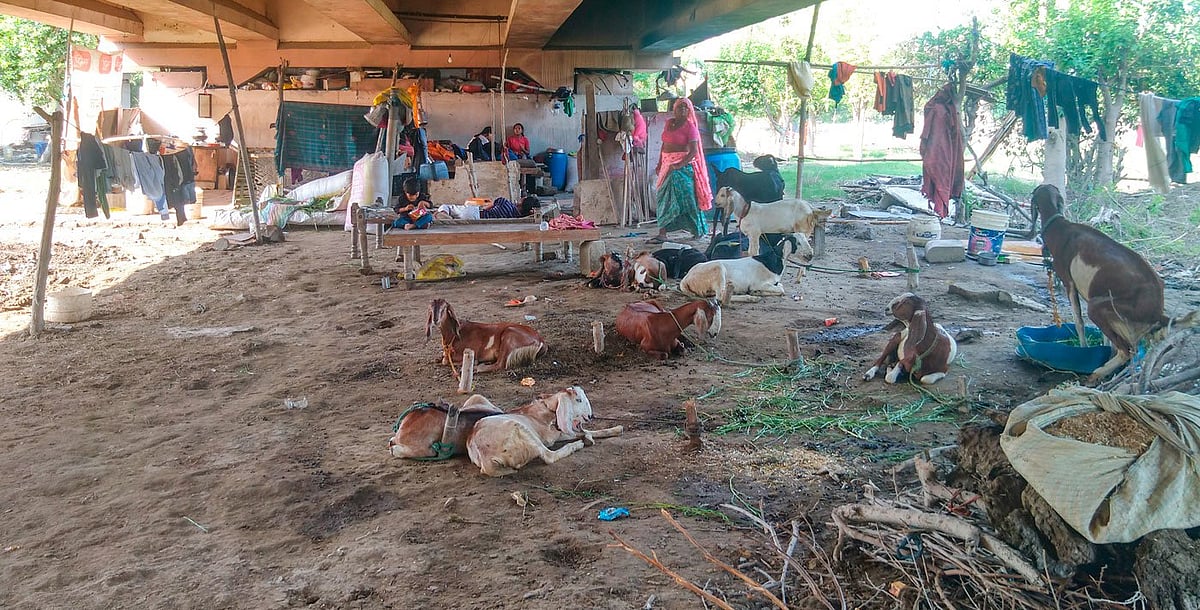Delhi's homeless flood victims asked to stay out of sight for G20 summit
Several displaced families have been living under a flyover for almost two months now, compelled to divert power from streetlights for their basic electricity needs

Hiralal rushed to pick up the family’s cooking cylinder. The 40-year-old was taking no chances as dark waters snaked around furiously, rushing into his home in Bela Estate, located close to Rajghat in Delhi.
It was the night of 12 July, 2023. Days of heavy rain had caused the Yamuna river to rise, and those like Hiralal who lived on its banks in Delhi had run out of time.
Chameli (who goes by Geeta), 60, a resident of Yamuna Pushta area in Mayur Vihar, hurriedly scooped up Rinky, her young neighbour’s tiny one-month-old baby. Meanwhile all around her, people were ferrying frightened goats and dazed dogs on their shoulders, losing several on the way. Hapless residents were gathering utensils and clothes before the rising and swiftly flowing water took all their belongings.
“By morning, the water was everywhere. There were no boats to rescue us. People ran to the flyovers, wherever they could find dry land,” said Shanti Devi, 55, Hiralal’s neighbour in Bela Estate. “Our first thought was to keep our children safe; the murky waters could have snakes and other creatures not visible in the dark.”
She watched helplessly as their food rations and children’s school books floated away in the water. “We lost 25 kg of wheat, clothes drifted off…”
A few weeks later, at their makeshift homes under the Geeta Colony flyover, the displaced survivors spoke to PARI. “Prashaasan ne samay se pehle jagah khaali karne ki chetaavni nahin di. Kapde pehle se baandh ke rakhe the, god mein utha-utha ke bakriyan nikaalin… humne naav bhi maangi jaanwaron ko bachaane ke liye, par kuch nahin mila [The authorities didn’t even make an announcement to tell us to move out in time. We’d already tied up our clothes, rescued as many goats as we could, we asked for a boat to save our animals but got nothing],” said Hiralal in early August.
Hiralal and Shanti Devi’s families have been living under the Geeta Colony flyover for almost two months now, compelled to divert power from streetlights for their basic electricity needs in their makeshift spot under the flyover, just to light a bulb at night. Twice a day, Hiralal lugs 20 litres of drinking water on his cycle from a public water tap in Daryaganj, nearly five km away.
They have not received any compensation for rebuilding their lives, and Hiralal, once a proud farmer on the banks of the Yamuna, is working as a construction labourer; his neighbour Shanti Devi’s husband Ramesh Nishad, 58, also a former farmer, is now standing in a long line of kachori (snack) sellers hawking wares on a busy road.
But even this immediate future is thrown into jeopardy as the government and Delhi gear up for the G20 meet. Hawkers have been ordered to clear off for the next two months. “Do not be seen,” is what the authorities say. “How will we eat?” asked Shanti. “In the name of showing off to the world, you’re destroying the homes and livelihoods of your own people.”
On 16 July, the Delhi government announced Rs 10,000 as relief for each flood affected family. On hearing the sum, Hiralal was incredulous. “What kind of compensation is this? On what basis did they come to this figure? Is 10,000 rupees what our lives are worth? One goat costs 8,000-10,000 [rupees]. It takes 20,000-25,000 [rupees] to build even a makeshift home.”
Like many others who live here, and lost the land they once cultivated, are now doing mazdoori (daily wage work), pulling rickshaws or desperately seeking domestic work. “Was a survey done to determine who lost how much?” they ask.
Six weeks later, the waters have receded but not everyone has received compensation. Residents blame the excessive paperwork and circuitous processes: “First they said get your Aadhaar card, bank papers, photos, then they asked for ration cards…,” said Kamal Lal. He is not even sure if the money will eventually come for the 150-odd families in the area, victims of a man-made disaster which could have been averted.
Previous attempts at seeking rehabilitation for the 700-odd old farming families living in the area who lost their land to state projects, have not moved forward. There is a constant ongoing tussle with authorities who want them to clear off. Whether ‘development’, displacement, disaster or display, these farmers have always been casualties in the scheme of things.
Kamal is part of the Bela Estate Mazdoor Basti Samiti group that has been asking to be compensated but, “the floods halted our protests”, says the 37-year-old, wiping off the sweat on a humid August afternoon at the site.
It is after 45 years that Delhi came near drowning again. In 1978, the Yamuna rose 1.8 m above its official safe level, touching 207.5 m; in July ths year, it crossed 208.5 m, an all-time record. The barrages in Haryana and Uttar Pradesh were not opened in time and the swollen river flooded Delhi, resulting in loss of lives, homes and livelihoods; crops and other water bodies also suffered extensive damage.
During the floods in 1978, the irrigation and flood control department of the government of NCT of Delhi noted, "damages were estimated at nearly Rs 10 crore, 18 lives were lost, and thousands of people were rendered homeless."
This year, after several days of rain in July that led to the floods, a PIL plea claimed that over 25,000 people were directly or indirectly affected. According to the Yamuna River Project: New Delhi Urban Ecology, steady encroachment of the floodplain will have severe consequences, “… wiping out structures built in low lying areas of the floodplain and inundating east Delhi with water”.
Around 24,000 acres have been cultivated on the banks of the Yamuna and farmers have been living here for more than a century. But the concretisation of the floodplains — temples, metro stations, Commonwealth Games Village (CWG) — has left less and less room for flood waters to spread.
“Nature will chart its course no matter what we do. Earlier, the water spread out during rains and floods, and now because there’s less space [in the floodplains], it was forced to rise to flow, and in the process destroyed us,” added Kamal of Bela Estate, residents of which are paying the price for the 2023 floods. “Saaf karni thi Yamuna, lekin humein hi saaf kar diya [they were supposed to clean the Yamuna but instead cleaned us out]!”
“Yamuna ke kinaare vikas nahin karna chaahiye. Yeh doob kshetra ghoshit hai. CWG, Akshardham, Metro yeh sab prakriti ke saath khilwaad hai. Prakriti ko jitni jagah chaahiye, woh toh legi. Pahle paani failke jata tha, aur ab kyunki jagah kam hai, toh uth ke ja raha hai, jiski wajah se nuqsaan humein hua hai [the area of the floodplains close to the Yamuna should not be developed. It’s already designated as flood-prone. Building the CWG, Akshardham temple, metro station on the floodplains is like playing with nature),” adds Kamal.
“Dilli ko kisne duboya (who drowned Delhi)?" The Delhi government’s irrigation and flood control department is supposed to prepare every year between 15 and 25 June. "Had they opened the barrage gates [in time], the water wouldn’t have flooded like this. Paani nyay maangne Supreme Court gaya [the water reached the Supreme Court to ask for justice],” said Rajendra Singh, not in jest.
The Alwar-based environmentalist pointed out that “this was not a natural disaster. Erratic rainfall has happened earlier too”, while addressing a public discussion, ‘Delhi’s Floods: Encroachment or Right?’ on 24 July, 2023 organised in Delhi by Yamuna Sansad, a people’s initiative to save the Yamuna from pollution.
“Heads should be rolling given what happened with the Yamuna this year,” said Dr. Ashvani K. Gosain, an expert member of the Yamuna monitoring committee set up by the National Green Tribunal in 2018.
“Water has velocity too. Without embankments, where will the water go?” asked Gosain, who advocates building reservoirs instead of barrages. An emeritus professor of civil engineering at Delhi's Indian Institute of Technology, he points out that the 1,500 unauthorised colonies as well as lack of street-level drains send water into sewer lines and “this brings diseases too”.
The Bela Estate farmers have already been living precariously with climate change, their cultivation halted, no rehabilitation and under threat of evictions. The recent floods are just the latest in a series of losses.
“It takes Rs 20,000-25,000 to build a 10 x 10 ft jhuggi [makeshift home] for a family of four or five. The waterproofing sheet alone costs Rs 2,000. If we hire labour to build our homes, we have to pay Rs 500-700 per day. If we do it ourselves we lose our day’s earnings,” says Hiralal, who lives with his wife and four children, aged 17, 15, 10, and 8. Even bamboo poles cost Rs. 300 each, and he says he will require at least 20 of them. Displaced families are unsure as to who is going to compensate them for their losses.
Then there is the cost of replenishing livestock, many of which were lost in the floods. “A buffalo costs anything upwards of Rs 70,000. You have to feed it well for it to stay alive and give milk. A goat that we keep for daily milk requirements of our children and tea costs Rs 8,000-10,000 to buy,” he adds.
His neighbour Shanti Devi told PARI that after her husband lost his fight to be identified as a landowner and cultivator on the banks of the Yamuna, he sells kachoris on a bicycle but barely manages to make Rs 200-300 a day. “The police take Rs 1,500 per cycle every month whether you stand there for three days or 30 days,” she points out.
The flood waters have receded, but other dangers lurk: waterborne diseases like malaria, dengue, cholera, and typhoid pose a threat while over 100 cases of eye flu per day were being reported in the immediate aftermath in relief camps which have since been dismantled. Hiralal was nursing a red eye when we met him. He held up a pair of overpriced sunglasses: “These are worth 50 but sold for Rs 200 because of the demand.”
Speaking for the families who await the inadequate compensation, he adds with a wry smile, “The story is not new, people always profit from others’ pain.”
(First published by the People's Archive of Rural India on 6 September 2023)
Follow us on: Facebook, Twitter, Google News, Instagram
Join our official telegram channel (@nationalherald) and stay updated with the latest headlines

